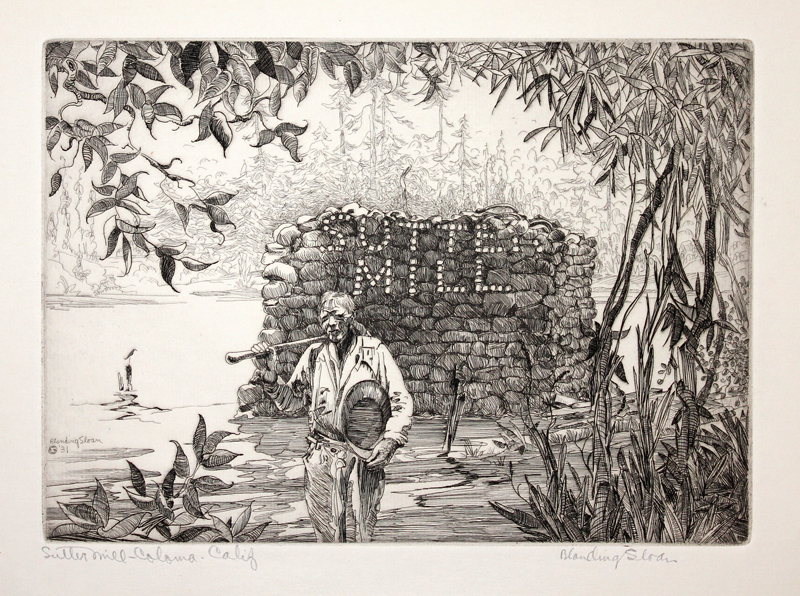
19th, 20th & 21st Century Fine Prints
707-546-7352 · fax 707-546-7924 · web: www.annexgalleries.com · email: artannex@aol.com
Sutter Mill, Coloma, Calif. by James Blanding Sloan

Sutter Mill, Coloma, Calif.
James Blanding Sloan
Sutter Mill, Coloma, Calif.
James Blanding Sloan
1886 - 1975 (biography)There is a label attached to the lower margin with a comment from Philip Johnston: "The Spot Where Gold Was Discovered in California. It's timbers have rotted and disappeared, but a cairn of stones marks the site of an old mill on the American River. Here dawned the first day of a golden epoch"
The eccentric, eclectic Caifornia printmaker James Blanding Sloan moved to Hollywood in 1930 and, in 1931 did a series of etchings chronicaling the gold country in Northern California during the 1849 Gold Rush.
This image depicts a miner standing before a stone wall in the American River with a sign that reads "Sutter Mill". Sutter Mill is located in Coloma, California in the Sierra Nevada and was named for a sawmill owner, John Sutter. In 1848 one of the construction workers, James W. Marshall, discovered gold at the mill and the great California Gold Rush (1848-1855). The population of San Francisco exploded from around 1000 to 25,000 residents in two years. The miners became known as the "forty-niners".
The "49ers" name was adapted by the San Francisco football franchise team in 1946, and merged into the NFL in 1949 making it the 10th oldest franchise.
Theater set designer and printmaker James Blanding Sloan was born in Texas on September 18, 1886, to Alexander Colvin Sloan and Henrietta Blanding. He grew up in Corsicana, Texas, where he received his early education and began acting in local theater. After his elementary years he studied at Austin College and in 1910 he enrolled at the Chicago Academy of Fine Arts (now the School of the Art Institute of Chicago). He would later become a teacher of color composition there. He shared a studio with printmaker B.J.O. Nordfelt and discovered color etching through George Senseney. In 1914 he participated in his first exhibition with the Chicago Society of Etchers.
Sloan's secondary interest remained in theater and throughout the 1910s he helped organize the Players Workshop in Chicago, producing scripts by Ben Hecht, Alice Gerstenberg and Max Bodenheim. He incorporated themes of politicial activism into his various endeavors and, as the U.S. began to enter the first World War, Sloan was arrested while posting flyers encouraging young men to protest the draft through conscientious objection.
Sloan relocated to New York in 1918 to design stage sets for Florence Ziegfeld's Ziegfeld Follies, as well as Earl Carrol and John Murrary Anderson. Meanwhile, he continued to exhibit his prints, gaining widespread acclaim for his etchings and blockprints. In 1923 Sloan left New York with Mildred Taylor, his second wife, intending to drive across the U.S. and embark on a trip to Asia. However, due to Sloan's ailing health, when they arrived in San Francisco they opted to remain and established a studio on Polk Street. This proved to be a prolific time for the artist, whose work greatly reflected his interest in questioning establishment. In addition to fine art on paper and canvas--gaining such a positive reaction that catalogue raisonné of his work was published in 1926--Sloan continued with his theatrical pursuits, establishing a puppet theater for adults that featured critical commentary on religion, sex, and politics, and and opening a movie theater that ran foreign films banned elsewhere.
Meanwhile, Sloan had established a second studio in Carmel-By-The-Sea, where he taught summer classes in etching, theater design, and painting through the University of California Extension Division. In 1929 he and Mildred founded Carmel's first international film festival, their first screening being The Light of Asia, a film about the life of Buddha performed by an all-Indian cast. In the early 1930's they moved to Hollywood where Sloan continued his fine art and theater work, as well as taking on a job with Disney. and in 1938 was hired as Regional Theater Director for the Deferal Theater Project. He left this post in 1940 to work as supervisor to the National Youth Administration for the American Southwest. After this period he co-produced films with his protegee, Wah Chang, in their company East West Films. Included in their productions was an interview with legenday singer Leadbelly and a film about nuclear disarmament, funded by the Lutheran Church. This led to his dismissal from Disney.
James Blanding Sloan died on October 5, 1975 in Canyon, Alameda County CA. His wake was allegedly attended by a diverse crowd that included businessmen and politicians to Hells Angels and Hippies.


